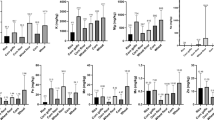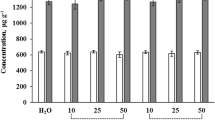Abstract
The total chromium content of a wide variety of breakfast cereals ( n =241) classified by cereal grain or blend of their (15 groups) was determined by graphite furnace atomic absorption spectroscopy (GFAAS) following acid mineralization with HNO3-H2SO4-HClO4. The reliability of the analytical method was validated. Differences in chromium content were found between breakfast cereals with different ingredients. The chromium content ranged from 0.12±0.01 μg/g of bran cereals to 0.35 μg/g of wheat-oat-rice-corn and corn-rice cereals.

Similar content being viewed by others
References
Moreiras O, Carvajal A, Campo M (1995) In: Guías alimentarias para la población española. Documento de consenso. Sociedad Española de Nutrición Comunitaria. (ed) Barcelona, pp 105–117
Ysart G, Miller P, Croasdale M, Crews M, Robb P, Baxter M, de L’Argy C, Harrison N (2000) Food additives and contaminants 17:775–786
National Institute of Nutrition (1999) Grains in the Canadian diet, no 28
Siega-Riz AM, Poplin BM, Carson T (2000) Preventive medicine 30:415–424
http://www.Kelloggs.com See Australia and New Zealand
Booth CK, Reilly C, Farmakalidi E (1996) J Food Comp Analysis 9:135–147
Tinggi U, Reilly C, Patterson C (1997) Food Chem 60:123–128
EVM/99/26/P (2000) Review of Cr. Expert Group on Vitamins and Minerals Secretariat
Anderson RA (1987) In: Mertz W (ed) Trace element in human nutrition. Academic Press, New York, pp 225–244
Cobo JM, Aguilar MV, Martínez Para MC (1995) Nutrition Res 15:555–564
National Research Council (U.S.) Subcommittee (1989) Recommended dietary allowances. National Academy Press, Washington, DC
Anderson RA, Bryden N, Polansky M (1993) J Am Diet Assoc 93:462–464
Biego GH, Joyeux M, Hartemann P, Debry G (1998) Sci Total Environ 217:27–36
Lendinez E, Lorenzo ML, Cabrera C, López MC (2001) Sci Total Environ 278:183–189
Perkin-Elmer (1995) Model 3110 Atomic Absorption Spectrometer. Hardware guide. Perkin-Elmer Corporation
Tinggi U, Reilly C, Patterson C (1997) Food Chem 66:123–128
Mateos CJ, Aguilar MV, Martínez-Para MC (2003) J Agric Food Chem 51:401–405
Lagarda MJ, Alonso de Armilo V, Farré R (1991) J Pharm Biomed Anal 9:191–194
Paschal DC, Bailey GG (1991) Atomic Spectrosc 12:151–154
Miller-Ihli, NJ, Greene FE (1992) J Assoc Off Anal Chem 75:354–359
McNaught AD, Wilkinson A (1997) International Union of Pure and Applied Chemistry. Compendium of Chemical Terminology, IUPAC Recommendations, 2nd edn. Blackwell Science, Oxford, 459 pp
Eurachem/Citac Guide (2000) Quantifying uncertainty in analytical measurements, 2nd edn
Bratakos MS, Lazos ES, Bratakos SM (2002) Sci Total Environ 290:47–58
Wilplinger M, Schönsleben I, Pfannhause W (1995)Z Lebens Unters Forsch 201:521–523
Adrian J (1991) Science des aliments 11:417–464
Abdalla AA, El Tinay AH, Mohamed BE, Abdalla AH (1998) Food Chem 2:243–246
Tolera A, Sundstol F (1999) Anim Feed Sci Technol 81:1–16
Sharma DC, Chatterjee C, Sharma CP (1995) Plant Science 111:145–151
Amissah JGN, Ellis WO, Oduro I, Manful JT (2003) Food Control 14:21–24
Schuhmacher MJ, Domingo M, Llobet JM, Corbella J (1994) Bull Environ Contam Toxicol 53:54–60
Luzzati A, Siragusa N (1981) Boll Chim Labor Provinciali 32:119–132
Lavado RS, Porcelli CA, Alvarez R (2001) Soil & Tillage Res 62:55–60
Svihus B, Gullord M (2002) Anim Feed Sci Technol 102:71–92
Deoshale YG (1982) The nutritive value of foods and the significance of some household processes. National Institute of Nutrition, New Delhi
Astiasarán I, Martínez A (1999) Alimentos: composición y propiedades. McGraw-Hill. Interamericana, Madrid
Tamime AY, Khaskheli M, Barclay MNI (2000) Lebensm-Wiss Technol 33:444–451
Acknowledgements
The authors thank Kellogg’s, Pascual and Nestlé for the breakfast cereals. This work was supported in part by the grant U.A. 004/96. CJ Mateos Vega was supported by the grant FPI CAM-96.
Author information
Authors and Affiliations
Corresponding author
Rights and permissions
About this article
Cite this article
Mateos, C.J., Aguilar, M.V. & Martínez-Para, M.C. Chromium content in breakfast cereals depending on cereal grains used in their manufacture. Eur Food Res Technol 220, 42–46 (2005). https://doi.org/10.1007/s00217-004-0993-3
Received:
Revised:
Published:
Issue Date:
DOI: https://doi.org/10.1007/s00217-004-0993-3




